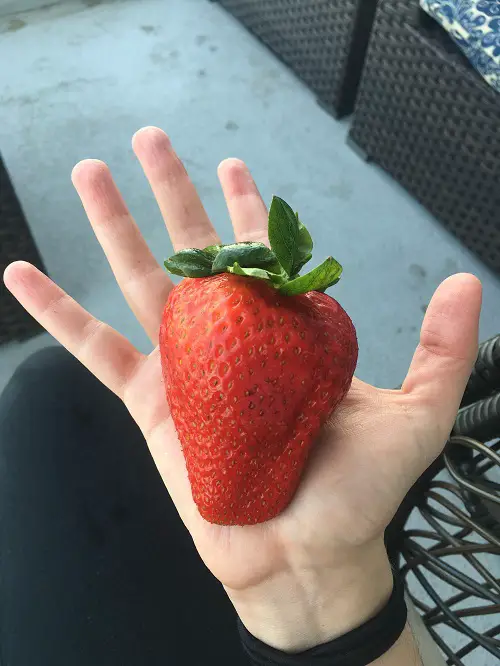Looking to grow Giant Strawberries? Well, it is easy and you can even do it in small containers! Let’s find out!
Giant strawberries can surprise you with their size along with the juicy taste! As you can see in the above picture, you can achieve a similar harvest with these tips!
How to Grow Giant Strawberries?
1. Pick the Right Variety
Do note that not all strawberries can grow on to become giants, and that’s why it is important to pick the right variety. Go for:
- ‘Aromas’: It grows large fruits with sweet flavor. The fruit also has a good shelf life.
- ‘Sequoia’: The one has a sweet flavor and is great for making jams.
- ‘Gigantella Maxi’: As the name suggests, it can go on to become some of the most giant ones!
- ‘Elsanta’: This plant produces medium to large-sized strawberries with a juicy texture.
- ‘Senga Sengana’: It has a dark red color and a sweet and aromatic flavor. Great for desserts.
2. Plant them At the Right Time of the Year
- Spring Planting: Planting these fruits in spring is the best as this ensures big strawberry fruits, thanks to the fact that it establishes the plant before the warm months.
- Fall Planting: For regions with mild winter months, fall planting is great. It gives the plant to establish strong roots before the start of the colder months, making sure it grows bigger and better strawberries!
3. Provide Adequate Spacing
To ensure you get giant strawberries, it is essential to provide at least 14-18 inches of space between the plants. This will make sure that strawberries get the proper sunlight and air penetration in every part, resulting in bigger fruits.
4. Scheduling Fertilization is IMPORTANT!

When to fertlize the plant is more important than which blend to use. Remember that!
- At the time of planting, add a handful of compost and well-rotted manure to the planting hole to give it a boost in healthy root development.
- The second feed will be at the time when the plant archives a height of 1-2 feet. Fertlize it with a balanced liquid blend diluted to 1/2 of its strength.
- The third dose will be when the plant starts flowering. It will support fruit development.
- The last feed is when you are done harvesting the fruits. This will replenish nutrients and help the plant for the next growing season.
5. Thinning Fruits to Lessen the Competition
Thinning is the process where you get rid of small and not-so-healthy fruits to help the plant relocate its energy into supporting healthy ones. It also makes the plant less dense, promoting better air and light reach.
Identify smaller or misshapen fruits and snip them out. Keep the ones that have a potential to become giant strawberries in the future. Also, look for fruits that are clustered together tightly and thin them out, too.
6. Do Not Ignore Companion Plants
Growing certain plants withe strawberry can help to deter pests and promote the plant’s growth by enhancing the soil’s nutrient content, which can greatly contribute to larger strawberries.
The best plants to go for is (1) borage, as it repels pests and attracts pollinators, whcih will ensure proper fruiting in the plant and (2) is thyme, which is a great hern to deter worms that can attack strawberries, resulting in poor fruit formation.
7. Go for Strategic Hand Pollination
If you are growing strawberries in enclosed spaces like a balcony, indoors, or a back garden, hand pollination is the way to go to ensure each flower becomes a big and juicy fruit!
Do it in the mid morning, using a small paintbrush. Simply collect the stamens of one flower gently with the paintbrush by revolving it inside the flower, collecting the yellow pollen grains. Then, carefully dab it onto the pistil of another flower.
This will mimic the natural pollination, something that bees do.






Hi, where about r u located.